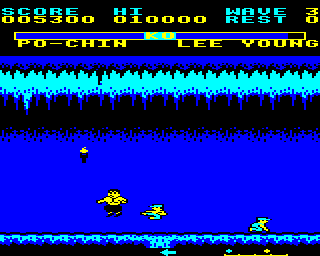Retro Replay Review
Gameplay
Yie Ar Kung-Fu 2: The Emperor Yie-Gah builds upon its predecessor’s foundation by delivering fast-paced, one-on-one martial arts action. Players control Lee Young as he squares off against a diverse roster of opponents, each armed with distinctive weapons and fighting styles. The depth of attack options—ranging from quick jabs and low kicks to powerful jumping strikes—ensures that each matchup feels fresh and strategic.
(HEY YOU!! We hope you enjoy! We try not to run ads. So basically, this is a very expensive hobby running this site. Please consider joining us for updates, forums, and more. Network w/ us to make some cash or friends while retro gaming, and you can win some free retro games for posting. Okay, carry on 👍)
The control scheme is remarkably responsive for an 8-bit title, with tight input recognition that allows skilled players to chain combos and evade incoming attacks fluidly. Learning the timing of sweeps, counters, and special moves is key to success, especially as enemies begin to anticipate your patterns. The feeling of mastering a new technique and landing it under pressure creates an addictive risk-versus-reward dynamic.
Opponents in Emperor Yie-Gah each carry unique weapons—swirling chain whips, spiked clubs, and even dart guns—that force Lee Young to adapt his approach. Defensive positioning and well-timed blocks are as important as offensive pressure, elevating the game from simple button-mashing to a more thoughtful duel. This variety keeps the challenge curve engaging and rewards players who take time to study each adversary.
The lack of a sprawling stage map is offset by the escalating difficulty of the one-on-one matches. Rather than wandering between locales, you progress through increasingly formidable challengers, culminating in the formidable encounter with the Emperor himself. This streamlined structure makes for a solid arcade-style experience, perfect for anyone seeking bite-sized bouts of combat mastery.
Graphics
As a title developed for the MSX and Famicom (NES) hardware, Emperor Yie-Gah showcases vibrant sprite work that remains charming decades later. Character sprites are crisp and well-defined, with each fighter sporting distinct color palettes to help you instantly recognize their fighting style and weapon reach. Lee Young’s animations—for punches, kicks, and flips—are smooth and expressive, lending a real sense of impact to each landed blow.
Backgrounds in each arena are simple but effective: tiled floors, traditional dojo backdrops, or lush garden settings provide just enough visual context without drawing attention away from the core action. Occasional parallax elements and animated details—flags fluttering, torches flickering—add life to the stages without overwhelming the limited color palette.
Special attack animations stand out against standard moves, with brief flashes or palette swaps that cue players to successful hits or knockdowns. While the overall resolution and sprite count are limited by the era’s hardware, the art direction cleverly maximizes clarity. Opponents’ weapons are clearly visible, ensuring you can anticipate their strikes from a distance.
The character portraits and intro screens maintain the game’s aesthetic, presenting stylized artwork that captures the spirit of an old-school martial arts tournament. Though there are no high-end effects like scaling sprites or real-time shadows, the graphical presentation holds up as a testament to efficient, character-driven design on 8-bit consoles.
Story
Yie Ar Kung-Fu 2 picks up the journey of Lee Young as he seeks to prove himself in the ultimate kung-fu contest. Unlike many modern fighters, the narrative here is conveyed in brief text interludes and illustrated title cards rather than lengthy cutscenes. This minimalist approach places the emphasis squarely on the battles themselves while still offering a clear goal: defeat all challengers and dethrone the Emperor Yie-Gah.
Each opponent you face contributes a small piece to the unfolding tale. From the masked swordsman guarding the garden arena to the stern bodyguards protecting the imperial throne room, the lineup feels like the gauntlet through which a true master must pass. Brief on-screen dialogue before key fights hints at rivalries and motivations, giving each victory emotional weight.
The central theme—a young disciple besting a proud emperor—creates a satisfying underdog narrative. Lee Young’s journey, though lightly sketched, resonates with anyone familiar with classic wuxia tropes. The lack of verbose exposition keeps the pace brisk, ensuring players remain focused on honing their skills rather than wading through walls of text.
While hardcore fans of story-driven fighters may find the plot thin, the game’s charming simplicity complements its arcade legacy. It delivers just enough context to frame each duel without bogging down the core martial arts action, making for a cohesive experience that balances narrative and gameplay.
Overall Experience
Yie Ar Kung-Fu 2: The Emperor Yie-Gah stands as a polished example of 8-bit fighting design, offering accessible yet challenging one-on-one combat. Its streamlined structure, responsive controls, and varied opponent roster make it ideal for quick play sessions or marathon practice runs. The focused progression—from local challengers to the final boss—gives a clear sense of accomplishment as you conquer each stage.
Replayability hinges on mastering every attack, discovering counter patterns, and improving completion times. Speedrunners and fighting enthusiasts alike will appreciate the tight frame data inherent in the moveset, which invites careful study and experimentation. For anyone looking to sharpen reflexes or enjoy a nostalgic trip back to early console fighters, this title delivers ample incentive to keep stepping into the ring.
While modern audiences may miss advanced features like tag battles or multi-layered story modes, Emperor Yie-Gah’s pure focus on one-on-one duels breathes new life into a classic formula. Its blend of straightforward presentation and escalating difficulty creates a timeless appeal that transcends its hardware limitations.
In summary, Yie Ar Kung-Fu 2 offers a compelling slice of retro fighting action. Whether you’re chasing old-school authenticity, seeking a rigorous test of timing and tactics, or simply hoping to revisit the golden age of NES-era brawlers, Lee Young’s quest to become a kung-fu master is a journey well worth taking.
 Retro Replay Retro Replay gaming reviews, news, emulation, geek stuff and more!
Retro Replay Retro Replay gaming reviews, news, emulation, geek stuff and more!









Reviews
There are no reviews yet.